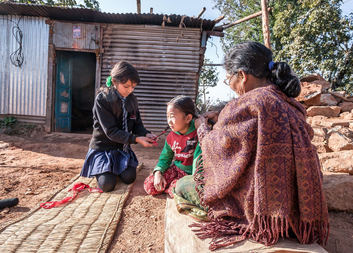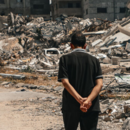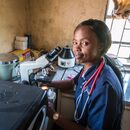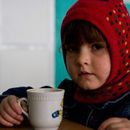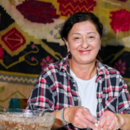Nepal was struck by devastating earthquake measuring 7.9 on the Richter scale on April 25, 2015. Several thousand people have died and many people were injured. The tragedy has caused enormous material damage, especially in the Sindhupalchok region. Caritas Czech Republic together with Caritas Swiss and their partners support the renovation of primary and secondary schools here.
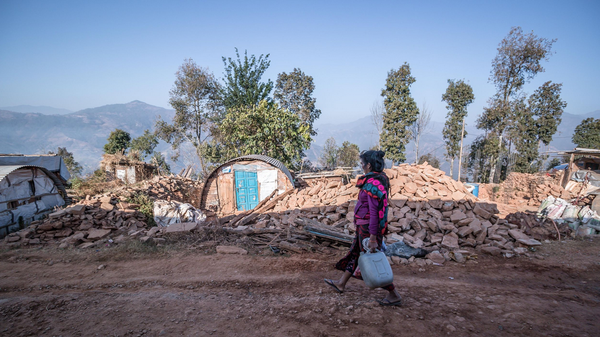 The rehabilitation of schools in remote mountain villages as Palchok is a tour de force. A lot of heavy material needs to be transported and there is no train. Only a small mountain road leads to Palchok. 200 small trucks loaded with sand, gravel, wood and cement fight their way up the mountain. From the district capital Melamchi the trucks can only drive in walking speed – centimeter by centimeter over an unpaved road with many potholes and water ditches. And the clock is ticking; when the monsoon sets in in June and the rain turns the dusty roads into soapy slides, the village is cut off from the rest of the country until end of September.
The rehabilitation of schools in remote mountain villages as Palchok is a tour de force. A lot of heavy material needs to be transported and there is no train. Only a small mountain road leads to Palchok. 200 small trucks loaded with sand, gravel, wood and cement fight their way up the mountain. From the district capital Melamchi the trucks can only drive in walking speed – centimeter by centimeter over an unpaved road with many potholes and water ditches. And the clock is ticking; when the monsoon sets in in June and the rain turns the dusty roads into soapy slides, the village is cut off from the rest of the country until end of September.
The topography is also a challenge for the engineers. The construction site is determined by nature: a small plateau high above the village, right behind it looms steep wooded rock wall. “We need to work with the limited options we have and make the best out of it”, Caritas program coordinator Thakur Tapa explains.
Away from the temporary solution, into the newly rehabilitated school
From the Palchok school yard the view goes over terraced maize, millet, rice and wheat fields. The roofs of the tin shacks in Jyotibhanjyang sparkle from far. This is where Nirjala lives.  The 13-year-old girl has been awake since 5 am. She has to clean the house and as every morning she will attend extra classes at 6:45 am. When she comes home from school, her grandmother awaits her with a meal. Both were very lucky on the 25th April 2015. Nirjala, who was playing in the school building with her friends like on many Saturdays, was able to run outside and save herself. Her grandmother was trapped under the ruins of her house, but Nirjala could free her after four hours. They escaped with a shock and were not hurt, but they still lost a lot – a beautiful house and a more or less comfortable life. In their new home - a hut with a corrugated tin roof – everything happens within a very small space; every centimeter is used. One corner is occupied by the beds and the other by the gas stove, in between, corncobs are lined up on a wall rack. Behind a curtain the family has piled up other supplies. “We cannot hang our clothes anywhere. We put them in the back of the room, but they become dirty. This is why the children are sometimes not dressed properly”, complains the grandmother. Life in the temporary shelter is harsh and the family does not feel safe. “Water penetrates through everywhere, mice are destroying the food and recently a snake came up to the front of our hat.”
The 13-year-old girl has been awake since 5 am. She has to clean the house and as every morning she will attend extra classes at 6:45 am. When she comes home from school, her grandmother awaits her with a meal. Both were very lucky on the 25th April 2015. Nirjala, who was playing in the school building with her friends like on many Saturdays, was able to run outside and save herself. Her grandmother was trapped under the ruins of her house, but Nirjala could free her after four hours. They escaped with a shock and were not hurt, but they still lost a lot – a beautiful house and a more or less comfortable life. In their new home - a hut with a corrugated tin roof – everything happens within a very small space; every centimeter is used. One corner is occupied by the beds and the other by the gas stove, in between, corncobs are lined up on a wall rack. Behind a curtain the family has piled up other supplies. “We cannot hang our clothes anywhere. We put them in the back of the room, but they become dirty. This is why the children are sometimes not dressed properly”, complains the grandmother. Life in the temporary shelter is harsh and the family does not feel safe. “Water penetrates through everywhere, mice are destroying the food and recently a snake came up to the front of our hat.”
This is where Nirjala is cleaning the dishes. Water comes from a big tub, which needs to be filled every day. “I do not have the strength to carry more than 5 liters. This is why I have to go several times a day to get water”, the grandmother explains and looks at Nirjala, “fortunately my granddaughter helps me with household chores, even though she has to work hard in school. I am so proud of her”. The 13-year-old withdraws into the house. She finishes her homework on a bed that she uses as desk. Then it is time to go – classes will start soon.
Nirjala wants to become doctor
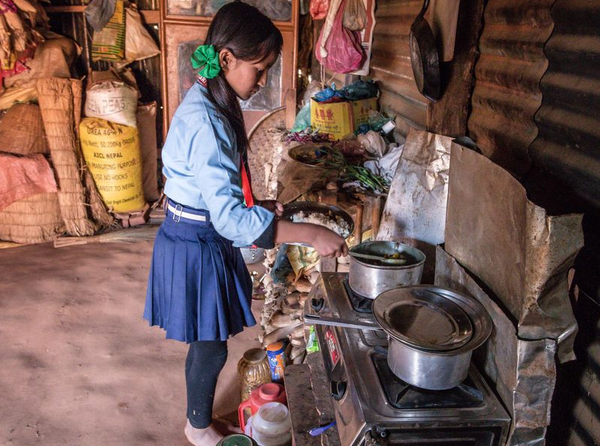 Fortunately, it is a walk of just a few minutes to school. Nirjala is looking for a seat on one of the school benches. The natural history class starts and the subject of today is salt. Nirjala and her classmates read out the text loudly. The walls are thin. Their voices blend in with the voices of next door’s class. Again and again small dust avalanches roll down the slope into the class rooms, triggered by trucks which drive on the unpaved streets above the school. “Sometimes it is difficult to learn here”, Nirjala admits.
Fortunately, it is a walk of just a few minutes to school. Nirjala is looking for a seat on one of the school benches. The natural history class starts and the subject of today is salt. Nirjala and her classmates read out the text loudly. The walls are thin. Their voices blend in with the voices of next door’s class. Again and again small dust avalanches roll down the slope into the class rooms, triggered by trucks which drive on the unpaved streets above the school. “Sometimes it is difficult to learn here”, Nirjala admits.
But the cramped conditions, extreme heat in the summer and freezing cold in the winter as well as the rattling tin roof will soon be history. In the near future, the temporary classrooms in Jyotibhanjang will be removed and the children can move into the new school rooms that were reconstructed by Caritas. Nirjala is very excited about that. “After the earthquake, I doubted that the school would ever be rebuilt. So, I was very happy when I heard about the support of Caritas”, the 13-year-old, who tied her hair together to two ponytails, recounts.
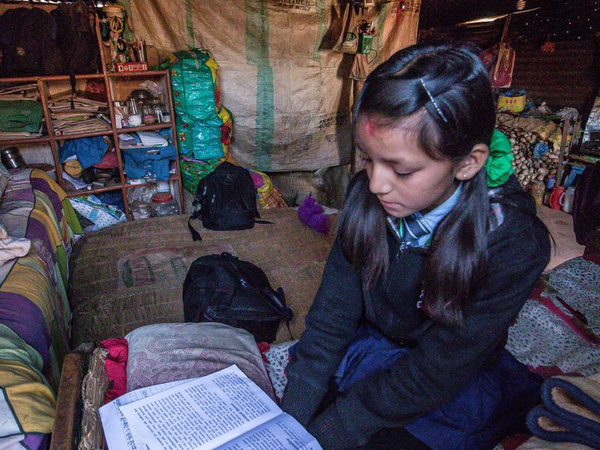 The girl with the big bright eyes knows exactly what she wants: “to become a doctor and help the people in my village, who do not have access to medical support”. Nirjala works hard to fulfill this dream and the family supports her wherever they can. But this is not easy. Like Tempa, Nirjala is growing up without a father. He left the family when she was nine years old. While the grandmother takes care of Nirjala and her three siblings, the mother runs their small farm and works the fields. The family does not have a secure income and the training to become a doctor is expensive. This makes the grandmother sometimes worry about the future. “I sometimes ask myself if we will be able to manage this all.”
The girl with the big bright eyes knows exactly what she wants: “to become a doctor and help the people in my village, who do not have access to medical support”. Nirjala works hard to fulfill this dream and the family supports her wherever they can. But this is not easy. Like Tempa, Nirjala is growing up without a father. He left the family when she was nine years old. While the grandmother takes care of Nirjala and her three siblings, the mother runs their small farm and works the fields. The family does not have a secure income and the training to become a doctor is expensive. This makes the grandmother sometimes worry about the future. “I sometimes ask myself if we will be able to manage this all.”
The schools that Caritas reconstructed symbolize one step back to a normal life. By the end of 2018, Caritas will rehabilitate 31 earthquake-safe and child-friendly schools in six villages in Sindhupalchok district.
Read all the story at Caritas Switzerland.

